Rose Chalice Veil Construction
Rose Chalice Veil Construction
This weekend past weekend was Laetare Sunday, one of the two Sundays in the Church Year when Rose-colored vestments are used. For this Ecclesiastical Sewing project, we are using two fabrics: an Ecclesiastical Brocade called Florence in the rose color and a tapestry fabric called Verona with Lurex. These Ecclesiastical fabrics are coming to the new website in the fall of 2015.
Adding Orphrey Trim
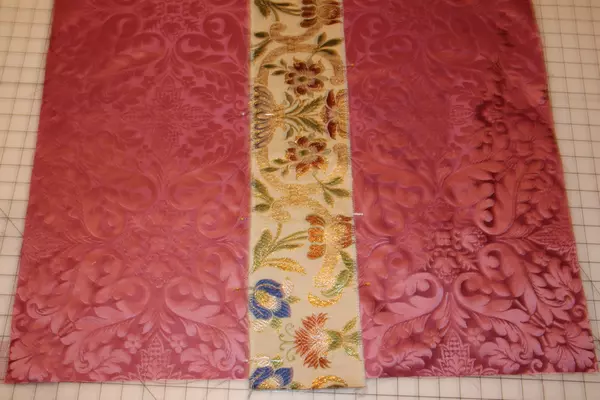
Part of the fun in making this Ecclesiastical Vestment set was determining the placement of the various motifs in the fabric. Utilizing the design motifs within the fabric to enhance the finished piece can make a project all the more fun. The positioning of motifs on this fabric offers some interesting possibilities.
If one looks closely at the corners on the above piece, you’ll notice a motif that aligns at a 45-degree angle, precisely where the fabric will fold into a point when draped over the chalice. Placing this motif in the corners worked out perfectly for creating a chalice veil that will have a finished dimension of 25 1/2″. (Please carefully check the size of your church’s chalice and pall to determine the correct size needed). The orphrey band is centered on a motif, and the patterns on either end of the orphrey band are perfectly symmetrical. The placement could not have worked out better! Not all orphreys will be symmetrical, and that is okay, too. Just watch the placement of the design motifs in the orphrey band.
The orphrey is basted in place, and stitched using a walking foot, or even feed foot to avoid “take up” or puckering. (Take-up happens when layers of fabric shift during stitching, resulting in puckers or bubbles where the fabric bunches up).
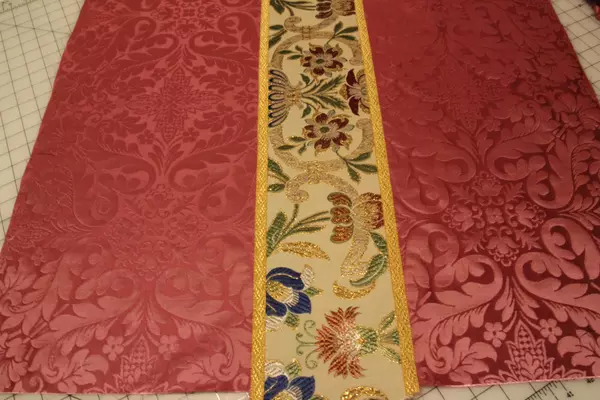
Adding Oak Leaf Trim
The next step in the process is to add the Oak Leaf Trim. This trim is woven with real metallic thread. It has an unusual, somewhat stiff feel, but stitches in place like a dream! This is a VERY nice trim, as in exceptionally NICE trim. It is pricey, comes in gold and silver colors, is available in three sizes of 1/2″, 1″, and 2″ widths, comes from the UK, and is available through the Ecclesiastical Sewing storefront.
The Oak Leaf trim was stitched with a very bright gold thread that was not quite metallic but had the appearance of a metallic thread.
Lining
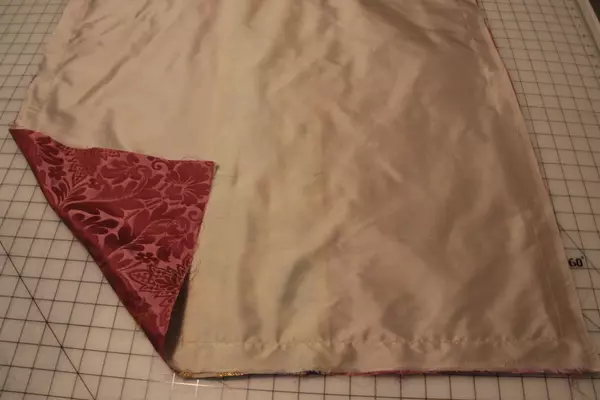
So what color does one use to line Rose Vestments? I tried the Roman Purple and violet. Those colors seemed to “deaden” the rose color. A friend suggested a red color, but it was not my favorite option. Perhaps later, rose and deep red it might grow on me. There is always gold as an option, but I would prefer an old gold and did not have the color on hand. So, that left…..cream? I did have a deeper cream silk shantung on hand courtesy of a clearance table. The color worked well. The silk was a natural choice for use with the Florence fabric.
The silk lining was cut about 1/8″ smaller than the chalice Veil face fabric. The reason? When the fabrics are stitched and turned, cutting the lining slightly smaller forces the face fabric to roll slightly in when turned, ensuring the lining never “peaks” out at the sides. This is a project where one does not want to understitch the lining to keep it in place, and certainly, top stitching is out of the question on fabrics like these. After all, Ecclesiastical Sewing is not sportswear. And if the proper techniques are employed, topstitching will not be needed to smooth seams or keep fabrics in place. So, little tricks like cutting the lining slightly smaller than the face fabric “do the trick” in allowing fabrics to turn and stay in place.
Constructing
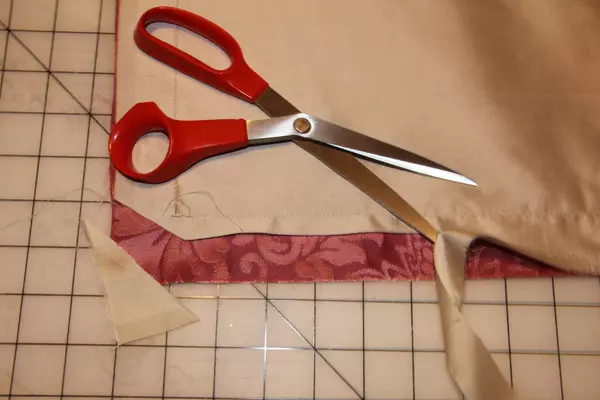
Next, the corners need clipping at a 45-degree angle, and the seam allowances need trimming and pressing before turning the fabric right side out.
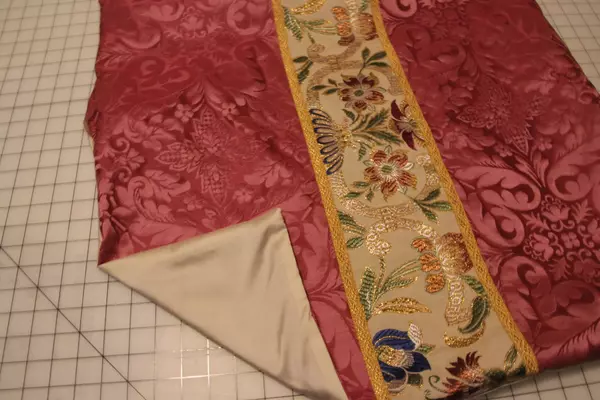
The final step is to turn the fabric’s right side out and adjust the corners with a point turner. Next, sew the opening closed with tiny blind stitches, and press the edges, making sure the lining rolls under slightly. And that completes the making of the chalice veil.
Orphrey Different Design
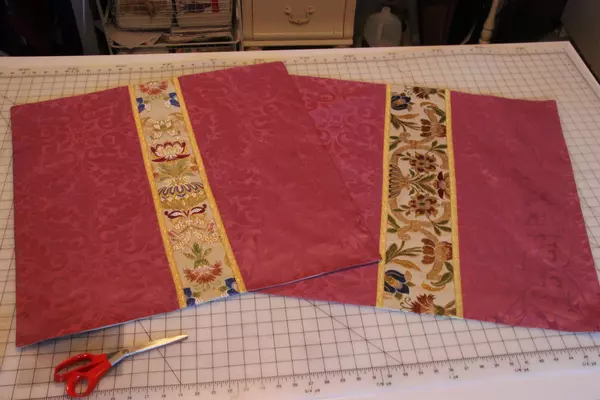
One other comment is worth noting: the orphrey bands can be cut from small pieces that remain from the Verona Tapestry. Select a portion of the fabric that is pleasing to look at and is balanced. The Chalice Veil on the left has a Jardiniere centered on the orphrey band. The orphrey band on the right was cut on the cross grain, using the flowers that are in the Jardiniere as the focal point of the orphrey.
Finished Design
Chalice veils are very simple to construct. The beauty of the finished piece lies in excellent workmanship construction techniques and appropriate design placement. The design of a chalice veil can be as simple or elaborate as the imagination allows. Although the chalice veils above do not have any trim around the edge, it is appropriate to use a cord as a decorative finish at the seam. Chalice veils often have a cross motif placed on the front edge, too.
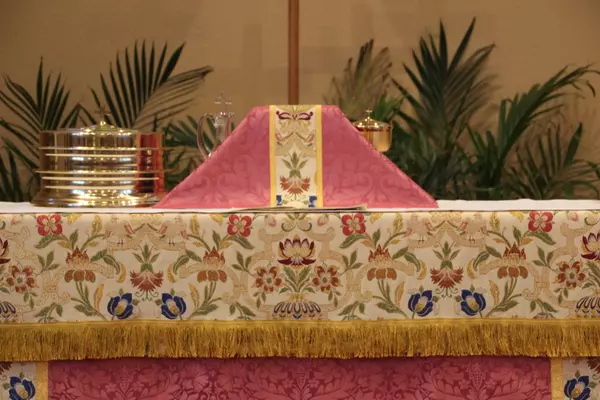
Now that the chalice veil has been worked through, it is time to start on some other Ecclesiastical Sewing projects. You might wonder what is in the works? Here is a tiny hint: the new project is fit for a King…..
Solo Dei Gloria
Be sure to visit our online storefront Ecclesiastical Sewing where you may shop for Liturgical Fabrics, altar linen fabrics, church vestment-making patterns, liturgical machine embroidery designs, church vestment trims, notions and so much more. You may also find us on Ecclesiastical Sewing on Facebook, Twitter, and Pinterest. Sign up for our mailing list at the bottom of the page on our online storefront and receive a free copy of our Small Linens Booklet as our way of saying thank you for following along.
What Sets a Truly Exceptional Chalice Veil Apart?
Chalice Veil Design from Althea Wiel
Sewing a Chalice Veil: Construction Details
Chalice Veil Orphrey Trim Part 2
Making a Chalice Veil Part II: Good Friday Chalice Veil
Passion Cross on Ash Wednesday Chalice Veil
Black and Gold Vestments: Making a Chalice Veil






 RSS - Posts
RSS - Posts
You must be logged in to post a comment.